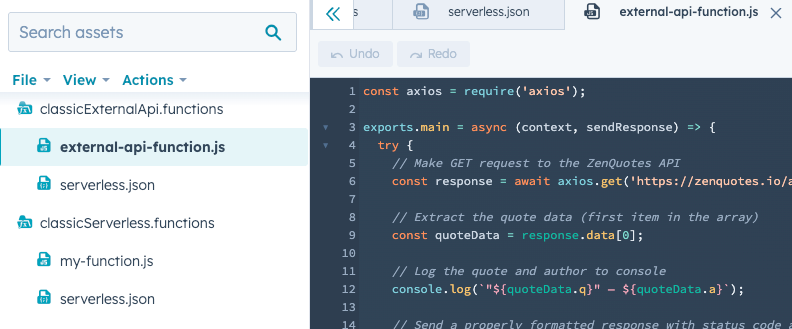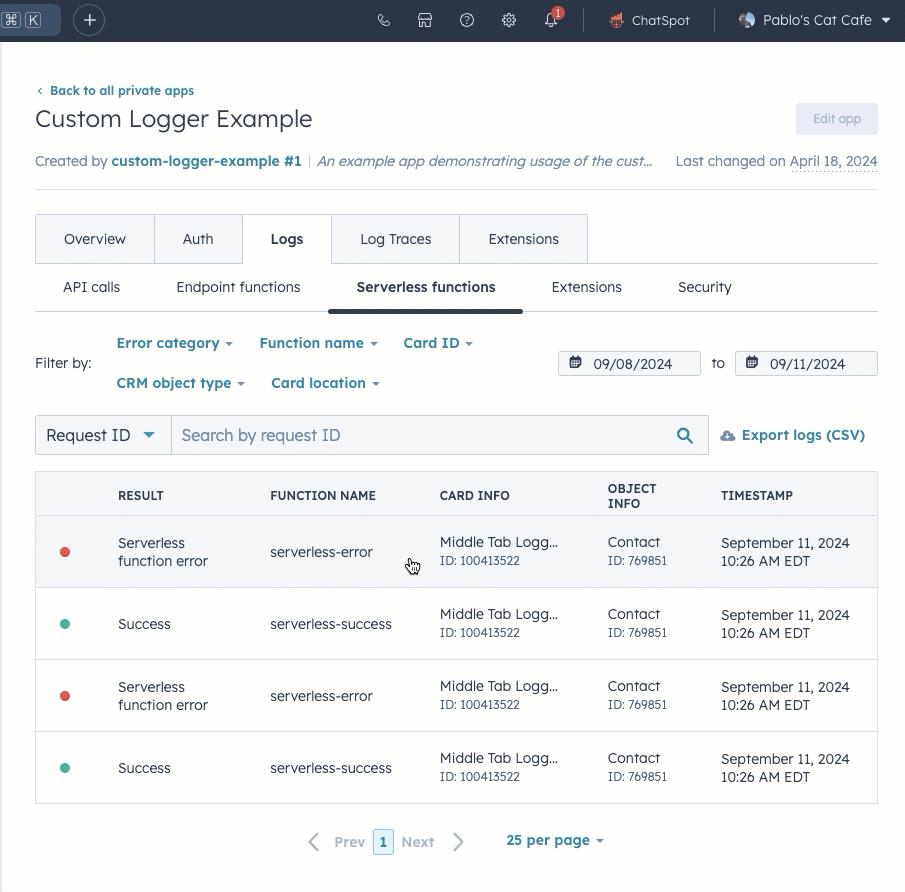Supported products
Supported products
Requires one of the following products or higher.
- Collect and store data in HubDB or the HubSpot CRM
- Run complex data calculators
- Dynamically fetch and display data from external systems
- Send form data to external systems
You may also want to check out the getting started with serverless functions
guide,
as well as the serverless functions reference
documentation.
Limits
Serverless functions are intended to be fast and have a narrow focus. To maintain performance, HubSpot serverless functions are limited to:- 50 secrets per account.
- 128MB of memory.
- no more than 100 endpoints per HubSpot account.
- the contentType
application/jsonwhen calling a function. - 6MB per invocation payload, which you might encounter when trying to upload a file with a serverless function, for example.
- 4KB for the amount of data that can be logged. When hitting this limit, it’s recommended to log after individual actions, rather than the final output.
Execution limits
- Each function has a maximum of 10 seconds of execution time.
- Each account is limited to 600 total execution seconds per minute.
- Up to 60 function executions that take 10 seconds each to complete.
- Up to 6,000 function executions that take 100 milliseconds to complete.
429 response. The execution time of each function is included in the serverless function logs.
Split dependencies
Serverless functions don’t support splitting JavaScript between multiple files, as they cannot import other functions. Instead, your serverless function JavaScript must be contained in one file. Alternatively, you can use webpack to bundle your code. Learn more about using webpack as a solution on HubSpot’s Community.Building functions
Serverless functions consist of a.functions directory containing a JavaScript file, a serverless.json configuration file, and a package.json file. The .functions directory can be named anything, as long as it contains the .functions suffix. Files stored in this folder are not publicly accessible.
serverless.json: the serverless function’s configuration file, which includes definitions for the function name, JavaScript file path, included secrets, and endpoint details..jsfile: the code that gets executed when the function is invoked. This file can have any name, as long as it ends in.js. You’ll specify the file name in theserverless.jsonfile.package.json(project-based only): for serverless functions built with projects, this file configures dependencies needed to execute the function.
Developer projects
You can use the developer platform to build and deploy a private app with serverless functions defined within it. This is the recommended path, as project-based serverless functions enable you to include third-party dependencies, as well as use the included private app for HubSpot scopes rather than manually managing app tokens through secrets. Within a developer project, the.functions directory should be placed within the app directory, as shown below.
Design manager
If you’ve built serverless functions for the CMS before HubSpot’s developer projects platform was released, this is the method that you’ll have used before. Similar to project-based serverless functions, these serverless functions are built locally, but they’re then uploaded to the design manager instead of a project. While this method is still supported, including third-party dependencies is not supported, so it’s recommended to build serverless functions using projects instead. For serverless functions created in the design manager, the.functions directory is uploaded directly to the design manager using the CLI, not through a developer project. The .functions directory should contain a serverless.json file and a JavaScript file containing the code to execute.

Authentication
There are two ways to authenticate requests made by serverless functions: private app access tokens and secrets.- Private app access tokens: because project-based serverless functions are bundled inside a private app, you can reference the app’s access token directly in your JavaScript code. Requests will have access to the scopes assigned to the private app. For serverless functions built in the design manager, you’ll need to create a secret to store a private app access token value. Calls authenticated with a private app access token count against your API call limits.
- Secrets: create secrets using the CLI to store credentials securely in HubSpot. You can make a secret available to a serverless function by including the secret name in the
serverless.jsonfile. Learn more about managing secrets using the HubSpot CLI.
Debugging
Project-based serverless functions
Log messages are produced every time HubSpot executes a serverless function. Below, learn how to access logs in HubSpot and locally using the CLI.In-app debugging
In HubSpot, you can view a serverless function’s log history, including successful requests and errors. To access a serverless function’s logs in HubSpot:- In your HubSpot account, navigate to CRM Development.
- In the left sidebar menu, navigate to Private apps.
- Select the private app that contains the serverless function.
- Click the Logs tab.
- To view logs for a serverless app function, click the Serverless functions tab. To view logs for a serverless endpoint function, click the Endpoint functions tab.
- In each tab, you can view logs for specific requests by clicking the request. You can also use the search bar to search by request ID.
- In the right panel, you can then click View log trace for a more in-depth breakdown of the request.

console.log() in your serverless function code for debugging purposes, then view its output in the function log details sidebar. Note that the message will not log directly to your browser console.
Local debugging
Log messages are produced every time HubSpot executes a serverless function. To view a serverless function’s logs in the CLI, run thehs project logs command. Learn more about using the hs project logs command.
There are two types of log messages produced:
- Log messages that record the execution of a function, along with its status and timing. For example:
2021-04-28T19:19:21.666Z - SUCCESS - Execution Time: 279ms - Log messages that are produced through console statements in the function code. For example, your serverless function JavaScript might include:
2021-04-28T19:15:13.200Z INFO Log some debug info
2021-04-28T19:15:14.200Z ERROR An error occurred
Design manager serverless functions
To help with troubleshooting your serverless functions, the CLI has anhs logs command which gives you the ability to view your function’s logs. In addition to individual function invocation responses, time of execution, and execution time, any console.log statement will also appear in function logs. Do not console.log secrets like API keys.